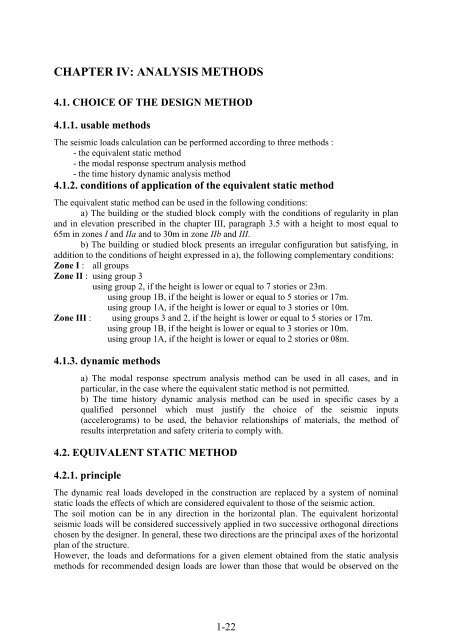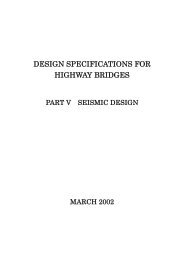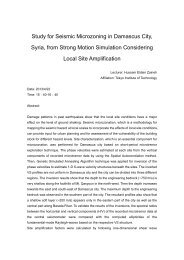algerian earthquake resistant regulations « rpa 99 - IISEE
algerian earthquake resistant regulations « rpa 99 - IISEE
algerian earthquake resistant regulations « rpa 99 - IISEE
Create successful ePaper yourself
Turn your PDF publications into a flip-book with our unique Google optimized e-Paper software.
CHAPTER IV: ANALYSIS METHODS<br />
4.1. CHOICE OF THE DESIGN METHOD<br />
4.1.1. usable methods<br />
The seismic loads calculation can be performed according to three methods :<br />
- the equivalent static method<br />
- the modal response spectrum analysis method<br />
- the time history dynamic analysis method<br />
4.1.2. conditions of application of the equivalent static method<br />
The equivalent static method can be used in the following conditions:<br />
a) The building or the studied block comply with the conditions of regularity in plan<br />
and in elevation prescribed in the chapter III, paragraph 3.5 with a height to most equal to<br />
65m in zones I and IIa and to 30m in zone IIb and III.<br />
b) The building or studied block presents an irregular configuration but satisfying, in<br />
addition to the conditions of height expressed in a), the following complementary conditions:<br />
Zone I : all groups<br />
Zone II : using group 3<br />
using group 2, if the height is lower or equal to 7 stories or 23m.<br />
using group 1B, if the height is lower or equal to 5 stories or 17m.<br />
using group 1A, if the height is lower or equal to 3 stories or 10m.<br />
Zone III : using groups 3 and 2, if the height is lower or equal to 5 stories or 17m.<br />
using group 1B, if the height is lower or equal to 3 stories or 10m.<br />
using group 1A, if the height is lower or equal to 2 stories or 08m.<br />
4.1.3. dynamic methods<br />
a) The modal response spectrum analysis method can be used in all cases, and in<br />
particular, in the case where the equivalent static method is not permitted.<br />
b) The time history dynamic analysis method can be used in specific cases by a<br />
qualified personnel which must justify the choice of the seismic inputs<br />
(accelerograms) to be used, the behavior relationships of materials, the method of<br />
results interpretation and safety criteria to comply with.<br />
4.2. EQUIVALENT STATIC METHOD<br />
4.2.1. principle<br />
The dynamic real loads developed in the construction are replaced by a system of nominal<br />
static loads the effects of which are considered equivalent to those of the seismic action.<br />
The soil motion can be in any direction in the horizontal plan. The equivalent horizontal<br />
seismic loads will be considered successively applied in two successive orthogonal directions<br />
chosen by the designer. In general, these two directions are the principal axes of the horizontal<br />
plan of the structure.<br />
However, the loads and deformations for a given element obtained from the static analysis<br />
methods for recommended design loads are lower than those that would be observed on the<br />
1-22








